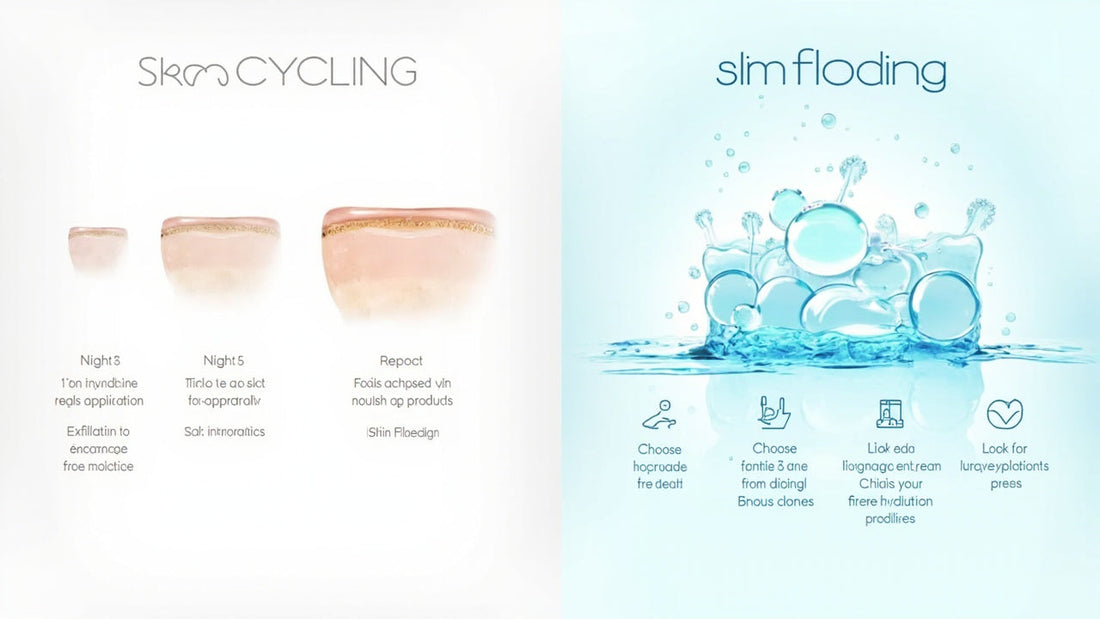
Skin Cycling vs. Skin Flooding: Which Trend Fits Your Routine?
Share
Two buzzy skincare trends are taking over TikTok and dermatology offices alike—skin cycling and skin flooding. But what do they actually mean, and more importantly, which one fits your unique skin needs and lifestyle? Let’s break down the science, benefits, and practicalities of each, so you can glow smarter, not harder.
Understanding Skin Cycling: Reset and Rebuild
Coined by dermatologist Dr. Whitney Bowe, skin cycling is a structured skincare routine that gives your skin time to recover between active treatments. It typically spans a four-night cycle: exfoliation on night one, retinol on night two, and recovery with hydration and barrier repair on nights three and four.
The philosophy is simple—more is not always better. Overloading the skin with actives nightly can lead to irritation, redness, and compromised barrier function. Skin cycling strategically alternates actives with recovery nights to reduce inflammation and enhance results.
If you're a working woman dealing with long office hours and limited time for an elaborate routine, this minimalist strategy can offer major payoff with fewer steps. On a typical night, you might apply the Refining Glycolic Serum by VivaGrace on exfoliation night, follow with Night Renew Retinol Cream on the second night, and use the Barrier Recovery Moisturizer for your recovery nights. This approach streamlines your routine without sacrificing efficacy.
Who Should Try Skin Cycling?
Skin cycling works best for those with sensitive or reactive skin, beginners starting actives, or anyone who’s experienced product fatigue. It’s also a great solution for students juggling late-night study sessions or young professionals who want results without the overwhelm.
Hydration First: The Rise of Skin Flooding
Skin flooding, on the other hand, is about layering hydration-focused products to deeply saturate the skin—perfect for dry, dehydrated, or barrier-compromised complexions. It typically starts with damp skin followed by a water-based serum, a humectant-rich essence or toner, and then sealing it all in with a thicker moisturizer.
Think of it as quenching your skin’s thirst. Ideal for post-travel recovery, harsh weather, or anytime your skin feels tight and thirsty, skin flooding floods the skin with moisture—literally. The trick is to layer products from thinnest to thickest without overwhelming your pores.
A typical routine might begin with a mist of Hydrating Essence Mist, followed by Dewy Glow Hyaluronic Serum, and sealed in with the Ceramide Repair Cream. These lightweight, clean formulations allow for deep hydration without greasiness.
Who Should Try Skin Flooding?
This method is ideal for dry, combination, or dehydrated skin types. It’s also great for post-treatment recovery or if you're navigating a shift in seasons (hello, fall-to-winter transition). Moms managing chaotic mornings can embrace this method too—it’s gentle, quick, and highly effective with just a few layers of hydration.
So, Which One Is Right for You?
If you crave structure, love a science-backed schedule, and are introducing potent ingredients into your routine, skin cycling is your go-to. If your skin is screaming for moisture, looks dull or flaky, or reacts poorly to actives, skin flooding might be your perfect match.
Some even alternate between the two—skin cycling for their nighttime actives, and skin flooding on recovery nights or in the morning to prep for makeup.
It’s not about trends—it’s about tuning into your skin’s needs and adjusting based on the season, your stress levels, or lifestyle shifts.
Your Skin, Your Rhythm
Skincare isn’t one-size-fits-all. Whether you're cycling your way to smoother texture or flooding your skin with hydration, both trends offer mindful, effective paths to healthier skin. Trust your skin’s signals, choose clean ingredients, and stay consistent. Your glow, your rules ✨
